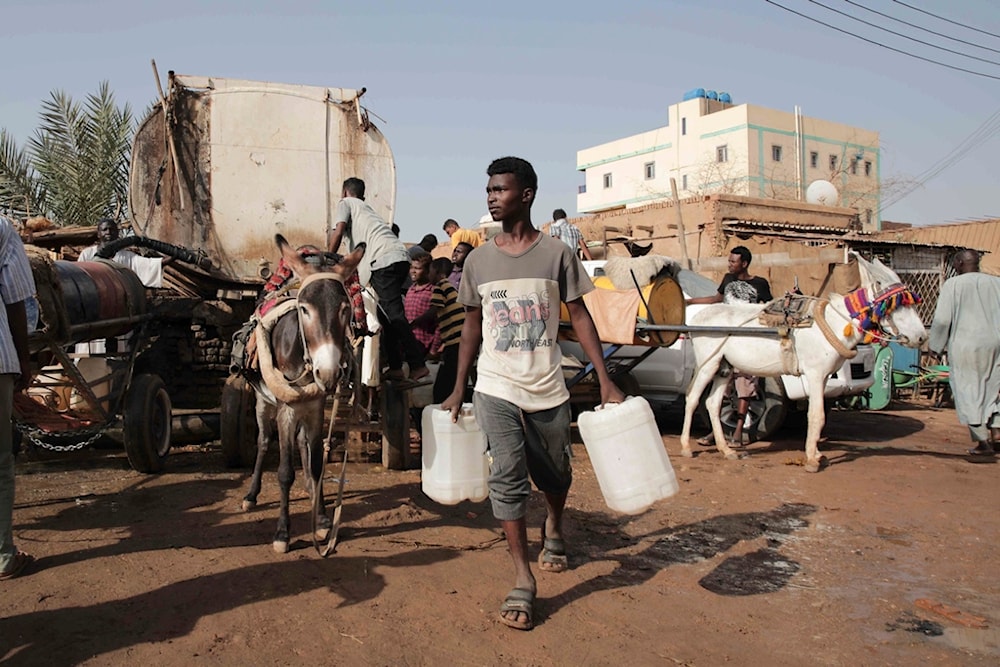25.6 million people threatened by acute food insecurity in Sudan: IPC
The Integrated Food Security Phase Classification (IPC) review, utilized by UN agencies, reveals that "famine is ongoing in July 2024 in Zamzam camp."
-

People gather to collect water in Khartoum, Sudan, on May 28, 2023, during a weeklong truce, brokered by the US and the Saudis. (AP)
The ongoing war in Sudan between the army and the rival paramilitary Rapid Support Forces (RSF) has driven the Zamzam camp near Darfur's besieged city of el-Fasher into famine, according to a UN-backed assessment released Thursday.
The Integrated Food Security Phase Classification (IPC) review, utilized by UN agencies, revealed that "famine is ongoing in July 2024 in Zamzam camp."
"The main drivers of famine in Zamzam camp are conflict and lack of humanitarian access," the report indicated.
Aid organization Plan International highlighted that "the IPC's latest report confirms what we and our fellow humanitarians have feared for months: that children in Sudan, having endured more than a year of harrowing conflict, are now dying of hunger."
Zamzam, a displacement camp in North Darfur state that originally hosted around 300,000 people, has seen its population swell to half a million in just a few weeks due to the fighting in nearby el-Fasher, pointed out Mohammed Qazilbash of Plan International.
Many residents have fled the brutal combat in the state capital, el-Fasher, the only major city in Sudan's vast western Darfur region not under the RSF's control.
The conflict erupted in April 2023 between the army and the RSF after a plan to integrate them failed, with both warring sides seizing territory.
Both sides have been accused of war crimes, including deliberately targeting civilians and obstructing humanitarian aid.
The war has resulted in tens of thousands of deaths and displaced over 10 million people, according to the United Nations.
The UN has described the situation as "one of the worst humanitarian crises in recent memory," with the vast majority of relief operations suspended due to the violence.
The IPC report highlighted that el-Fasher airport "is not accessible for humanitarian deliveries due to insecurity," adding that the last "delivery of food assistance to Zamzam camp was in April."
Medical charity Doctors Without Borders (MSF) confirmed last month that 63,000 children in Zamzam camp "qualify as malnourished," with 10% "severely, acutely malnourished."
The IPC reported that 14 months into the conflict, Sudan is experiencing the worst levels of acute food insecurity in the country's history.
It pointed out that 25.6 million people, more than half of Sudan's population, are facing crisis conditions or worse from June to September 2024, coinciding with the lean season.
According to the IPC's food security measurement criteria, crisis conditions or worse in Sudan correspond to phase three or higher on the food security classification scale.
The IPC added that 755,000 people are facing catastrophe (phase five of the IPC) in 10 states, including the greater Darfur states, as well as South and North Kordofan, Blue Nile, Al Jazirah, and Khartoum.
The report highlighted that 8.5 million people (18% of the population) are facing emergency conditions (phase four of the IPC).
The IPC warned that there is a risk of famine in 14 areas affecting the population, displaced persons, and refugees in the greater Darfur states, greater Kordofan, Al Jazirah, and some hotspots in Khartoum, if the conflict escalates further, including through increased mobilization of local militias.
The report noted that the situation is particularly critical for populations trapped in areas affected by direct conflict, insecurity, and lack of protection, especially in the greater Darfur states, greater Kordofan, Khartoum, and Al Jazirah.
According to the report, at least 534,000 displaced persons and refugees in conflict-affected areas and states with available data (representing approximately 20% of the displaced population in Sudan) are likely to face critical or catastrophic levels of acute food insecurity (phase four or five of the IPC).
The latest findings indicate a severe and rapid deterioration in the food security situation compared to the previous IPC update issued in December 2023.
The IPC reported a 45% increase in the number of people in phase three of the food security classification or higher (from 17.7 million to 25.6 million) from June to September 2024 compared to the period from October 2023 to February 2024.
The report also noted that the number of people in phase four of the IPC (emergency) increased by 74%, by more than 3.6 million people. Additionally, the number of people in phase five of the IPC (catastrophe) increased from zero to 755,000, according to the report.
Read more: No talks to be held before Jeddah Declaration implemented: Sudanese FM

 5 Min Read
5 Min Read








